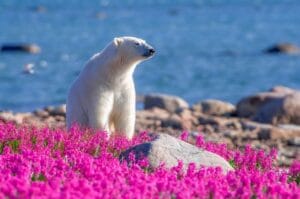Problems in an Arctic village as people and polar animals deal with global warming

Would you like some polar bear advice from me? Tee, a self-assured 13-year-old we meet when visiting a high school in Churchill, Canada, asks. She uses her hands to measure a distance of around 30 cm before saying, “Make a fist and punch it in the nose if there’s a bear this close to you.” Tee doesn’t have to test this suggestion yet. Bear safety is a part of daily life, though, because you’re growing up next to the biggest land predator on Earth.
Churchill is referred to as the world’s polar bear capital. The village is situated on the western side of Hudson Bay, which thaws every year, forcing the bears to come ashore. Hundreds of bears congregate here to wait as the fall freeze sets in.
Sea ice serves as a large dinner plate for polar bears, giving them access to seals, their primary food source. Since they haven’t eaten much on land this summer, they are most likely looking forward to a large dinner of seal blubber.
The Arctic is home to 20 distinct polar bear subpopulations. One of the best-researched and most southern is this one. The decrease is linked to the bay’s current ice-free duration, which is lengthening due to climate change.
Without sea ice, there would be no place to hunt frozen seals. These days, bears stay on land for roughly a month longer than their grandparents did, says Alysa. Mothers are under pressure because of that. It is more difficult to remain pregnant and support those unborn children when there is less food available.
The bears bring thousands of tourists and conservation scientists to Churchill each year, even though their long-term existence is in doubt.
Attacks by polar bears are uncommon, but they pose a threat to those who live and work in remote Arctic areas. In Canada’s northern Nunavut territory, two polar bears killed a Canadian worker earlier this year close to a remote defense station.
Churchill faces the odd task of coexisting with these ice-dependent predators at a time when the Arctic climate is changing more quickly than ever before: This area is experiencing a long-term reduction in polar bear populations. However, bears are spending more of the year on land, which increases the likelihood that bears and humans will come into touch in the near future.
Traveling to Churchill, the world’s polar bear capital

While you can spot polar bears in the Arctic and Svalbard, it’s tough to know where to search along their enormous coastlines and your chances of seeing them up close are small. Of the 25,000 polar bears in the world, about 17,000 live in Canada, and Churchill, in northern Manitoba, is by far the greatest location to watch them.
It is nearly a given that they will be here each year, on the edge of Hudson Bay. They are so regular in the area that there is an unspoken rule that people keep houses and cars unlocked in case someone needs to leave quickly.
In the spring, many bears enter the bay on ice floes. After that, they scatter around the nearby tundra, using it as a base during the summer months when they cannot catch seals and must rely on their fat stores for sustenance.
They gather around the bay as winter draws near, waiting for the water to ice before returning to consume their share of seals. Specialized lodges in and around Churchill provide six- or seven-day polar bear viewing tours. Planning in advance is crucial because these cruises only run briefly from July to August and October to November.
A warning about witnessing polar bears while walking
Every care is taken to keep you safe when monitoring polar bears. Bears’ body language is something that guides are trained to read. Additionally, they are proficient marksmen, therefore they will always take guns with them when out on walks. People in Churchill are on high alert, and it quickly becomes known if a bear has strayed onto the streets. If you wish to go around town alone, it’s recommended to ask your guides, lodge employees, and locals.
